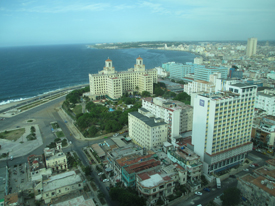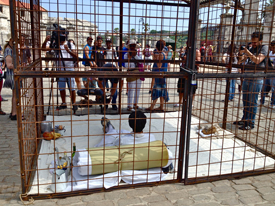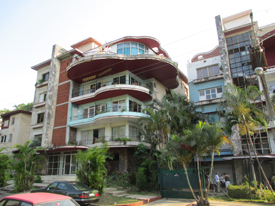CAA News Today
CAA Members Go to Havana
posted Aug 11, 2015
Last May CAA offered a trip to Cuba to visit the Havana Biennial. In an essay, Katherine Jánszky Michaelsen, a professor of art history at the Fashion Institute of Technology, State University of New York, and a CAA member, describes her experiences in this Caribbean capital city, newly reopened to American citizens.
Outside the airport terminal we’re hit by blinding sunlight and a riot of tropical color—a golden-shower tree, and a row of the famed vintage Cadillacs and Buicks painted in Day-Glo shades of fuchsia, turquoise, and green. All week long sunshine, blue skies, lush vegetation, and vivid colors provide the backdrop of our Havana sojourn; and then there’s the music; on every other street corner someone is making music—not to mention that this is the home of the ever-popular Buena Vista Social Club band.
Timed to coincide with the XII Bienal de la Habana, the CAA trip also overlapped with the onset of the normalization of diplomatic relations between the United States and Cuba. Although Europeans have been traveling to Cuba all along, this was the first year that large numbers of Americans were able to attend the biennial. Celebration was in the air. But testing the climate for change was Tania Bruguera, the dissident Cuban artist and free-speech advocate, who was arrested—not for the first time—at a live reading she held of Hannah Arendt’s 1951 book, The Origins of Totalitarianism. Two members of our group were present at the mêlée.
As tourists we were fortunate to enjoy the expertise and connections of the Cuban-born organizer of the trip, Adolfo Nodal, a former director of the Department of Cultural Affairs in Los Angeles and author of the pioneering book on Cuban art, who has been leading trips to Cuba for a number of years. Thanks to Al, who was one of the producers, we were able to attend the world premiere of the opera Cubanacán: A Revolution in Forms; and we were invited to savor roast pork in the garden of his friend, the artist Kadir López Nieves, with whom he is working on the restoration of Havana’s vintage neon signs. In addition to our spirited and fluently English-speaking guide, Gretell Sintes, another bonus was the considerable experience of CAA member and Xavier University associate professor of art history Alison Fraunhar, also a Cuban art specialist who, for example, arranged a special lecture by Nelson Herrera Ysla, one of the original founders of the Havana biennial in 1984. Finally, traveling with CAA top brass Linda Downs and DeWitt Godfrey, and a busload of like-minded, art-savvy colleagues, ensured the exchange of useful tips, stimulating conversation, and beautiful photographs by Sherman Clarke, among others.
 Every morning after partaking of the breakfast buffet that always included heaps of sliced mangoes, papayas, and melons, we assembled in the grand hall of the venerable oceanfront Hotel Nacional, built by McKim, Mead & White in 1930. In the evenings, after a full day of sightseeing, we’d lounge in the palm-tree-lined veranda sipping mojitos to the sound of a female salsa band. As the biennial venues were scattered around the city, it was possible to view historic tourist attractions—like the Plaza de la Revolución, or San Cristóbal cathedral, and at the same time take in a Tino Sehgal performance at the Centro de Arte Contemporáneo Wifredo Lam—or browse and buy prints at the Taller Experimental de Gráfica. Sales transactions can be made entirely on trust: you chose the work, take it with you, and send the check in the agreed amount to the Miami address of a relative or friend of the artist.
Every morning after partaking of the breakfast buffet that always included heaps of sliced mangoes, papayas, and melons, we assembled in the grand hall of the venerable oceanfront Hotel Nacional, built by McKim, Mead & White in 1930. In the evenings, after a full day of sightseeing, we’d lounge in the palm-tree-lined veranda sipping mojitos to the sound of a female salsa band. As the biennial venues were scattered around the city, it was possible to view historic tourist attractions—like the Plaza de la Revolución, or San Cristóbal cathedral, and at the same time take in a Tino Sehgal performance at the Centro de Arte Contemporáneo Wifredo Lam—or browse and buy prints at the Taller Experimental de Gráfica. Sales transactions can be made entirely on trust: you chose the work, take it with you, and send the check in the agreed amount to the Miami address of a relative or friend of the artist.
 One day in the historic district we stumbled upon a large cage with a man wearing lace tights and stack heels locked inside. We later found out that this was a work by the Indian performance artist Nikhil Chopra, who after three days painting what he saw from behind the bars, hacksawed himself out and walked off to the delight of the cheering crowd that followed him. One particularly hot afternoon, we squeezed like eager sardines into the Church of San Francisco de Paula to watch 82-year-old artist Michelangelo Pistoletto smash large mirrors with a mallet.
One day in the historic district we stumbled upon a large cage with a man wearing lace tights and stack heels locked inside. We later found out that this was a work by the Indian performance artist Nikhil Chopra, who after three days painting what he saw from behind the bars, hacksawed himself out and walked off to the delight of the cheering crowd that followed him. One particularly hot afternoon, we squeezed like eager sardines into the Church of San Francisco de Paula to watch 82-year-old artist Michelangelo Pistoletto smash large mirrors with a mallet.
The Malecón seawall was another venue where art and life mixed seamlessly. To make up for the fact that there is no beach, Arlés del Rio created a fake one complete with sand and thatch-roofed cabañas. All along the five-mile promenade tourists and locals mingled amiably among the assorted works of art; children clambered on sculptures as if they were jungle gyms; and occasionally a wave crashing against the wall would douse us with a welcome cool spray. We were not cautioned, nor evidently did we need to be—public safety was not an issue. We saw no beggars, and apart from traffic cops there was no visible police presence. But evidence of poverty was everywhere. Unlike the spiffy, lovingly restored vintage models lined up in front of our hotel, if you hailed a cab in the street, you were likely to get a Soviet-era Lada with missing window and door-handles, springs poking through the seat, and a rattling engine spewing black fumes. Whole neighborhoods are crumbling and derelict; former single-family houses in residential areas have been chopped up into numerous smaller units; elegant mansions are in ruins; and iconic modernist buildings from the 1950s have peeling paint. Architectural preservationists describe this neglect as “preservation by poverty,” meaning that paradoxically poverty has left extant what urban renewal would have inevitably destroyed. Designers in Havana (and elsewhere) have opportunistically embraced the romantic aesthetic of ruins. For example, Guarida, one of the top restaurants in Havana, is located in a ruined building where laundry hangs on a line in the entrance hall. Likewise, an international group show, Montañas con una esquina rota (Mountains with a Broken Corner), curated by artist Wilfredo Prieto, was staged in the roofless ruin of a former bicycle factory.
Whole neighborhoods are crumbling and derelict; former single-family houses in residential areas have been chopped up into numerous smaller units; elegant mansions are in ruins; and iconic modernist buildings from the 1950s have peeling paint. Architectural preservationists describe this neglect as “preservation by poverty,” meaning that paradoxically poverty has left extant what urban renewal would have inevitably destroyed. Designers in Havana (and elsewhere) have opportunistically embraced the romantic aesthetic of ruins. For example, Guarida, one of the top restaurants in Havana, is located in a ruined building where laundry hangs on a line in the entrance hall. Likewise, an international group show, Montañas con una esquina rota (Mountains with a Broken Corner), curated by artist Wilfredo Prieto, was staged in the roofless ruin of a former bicycle factory.
 Always at the ready, our tour bus comfortably transported us to outlying sites like Morro Cabaña, the historic colonial fortress on a hill that commands a breathtaking view of the city. A warren of small rooms connected by low barrel-vaulted corridors served as galleries that housed Zona Franca, an exhibition of about one hundred solo and group shows of both acclaimed and emerging Cuban artists. One afternoon we were taken to the Romerillo neighborhood where a year ago Alexis Leyva Machado, the artist known as Kcho, inaugurated (with a rare, surprise public appearance by Fidel Castro) an experimental community project, the Estudio Romerillo. For the biennial he organized an exhibition that took over the entire neighborhood and included artists from all over the world. There is a strong tradition of community service and sharing in Cuba, and established artists who enjoy special privileges are often moved to engage in activities to serve the common good. Carlos Garaicoa, a Cuban artist with an international reputation, is another example. In his spacious studio in a modernist building, he staged a group exhibition to launch Artista x Artista, an international exchange program that will include artist residencies and is based on the Open Studio program he started in Madrid in 2007. Yet another initiative created over the course of a decade for the benefit of the fishing village of Jaimanitas is an extensive and festive work of public art, Fusterlandia. Throughout the neighborhood, starting with his own house, the artist José Rodríguez Fuster painted murals and decorated the walls of dozens of houses with colorful ceramic shards in the manner of Antoni Gaudí.
Always at the ready, our tour bus comfortably transported us to outlying sites like Morro Cabaña, the historic colonial fortress on a hill that commands a breathtaking view of the city. A warren of small rooms connected by low barrel-vaulted corridors served as galleries that housed Zona Franca, an exhibition of about one hundred solo and group shows of both acclaimed and emerging Cuban artists. One afternoon we were taken to the Romerillo neighborhood where a year ago Alexis Leyva Machado, the artist known as Kcho, inaugurated (with a rare, surprise public appearance by Fidel Castro) an experimental community project, the Estudio Romerillo. For the biennial he organized an exhibition that took over the entire neighborhood and included artists from all over the world. There is a strong tradition of community service and sharing in Cuba, and established artists who enjoy special privileges are often moved to engage in activities to serve the common good. Carlos Garaicoa, a Cuban artist with an international reputation, is another example. In his spacious studio in a modernist building, he staged a group exhibition to launch Artista x Artista, an international exchange program that will include artist residencies and is based on the Open Studio program he started in Madrid in 2007. Yet another initiative created over the course of a decade for the benefit of the fishing village of Jaimanitas is an extensive and festive work of public art, Fusterlandia. Throughout the neighborhood, starting with his own house, the artist José Rodríguez Fuster painted murals and decorated the walls of dozens of houses with colorful ceramic shards in the manner of Antoni Gaudí.
Havana’s Museo Nacional de Bellas Artes (MNBA) comprises two separate buildings. The first, a majestic structure built in 1913 devoted to “arte universal,” was the venue for an exhibition titled Wild Noise—a collaboration with the Bronx Museum of the Arts that included an international roster of artists and explored a series of contemporary themes like identity, style, architecture, and community that are relevant to both the Bronx and Havana. Overseen by Bronx Museum director Holly Block, who has been engaged with Cuban art for two decades and is the author of Art Cuba: The New Generation, the exhibition was hailed as the most extensive cultural exchange between the US and Cuba in over fifty years; it will be followed in 2016 by an exhibition at the Bronx Museum organized by the Havana MNBA. A few blocks away, a modernist building from the 1950s that was fully restored and enlarged in the late 1990s showcases Cuban art from colonial times to the present. Except for the conspicuous absence of the obligatory museum book and gift shop, both the building and installation could easily hold their own anywhere in the world.
 The highlight of the trip for many of us was the campus of the National Art Schools, now known as ISA (Instituto Superior de Arte). It is the subject of a book by John Loomis, Revolution of Forms: Cuba’s Forgotten Art Schools, and a poignant 2011 documentary, Unfinished Spaces, by Alysa Nahmias and Benjamin Murray. Both works tell the story that is also the subject of the opera Cubanacán: A Revolution of Forms that we attended. In 1961, while playing golf at the Havana Country Club in Cubanacán, Fidel Castro and Che Guevara had the idea that the verdant grounds of this symbol of wealth and privilege would be an ideal setting for a complex of tuition-free art schools. Architect Ricardo Porro, charged to build “the most beautiful city of the arts,” enlisted the help of two Italian colleagues Roberto Gottardi and Vittorio Garatti. Of the five proposed schools three (music, ballet, and theater arts) were sadly left unfinished in 1965 when, due to Cuba’s rapprochement with the Soviet Union, the political climate changed drastically. These buildings are now in a state of ruin and overgrown with vegetation. But the schools of modern dance and plastic arts by Porro were completed, recently restored, and continue to be in use.
The highlight of the trip for many of us was the campus of the National Art Schools, now known as ISA (Instituto Superior de Arte). It is the subject of a book by John Loomis, Revolution of Forms: Cuba’s Forgotten Art Schools, and a poignant 2011 documentary, Unfinished Spaces, by Alysa Nahmias and Benjamin Murray. Both works tell the story that is also the subject of the opera Cubanacán: A Revolution of Forms that we attended. In 1961, while playing golf at the Havana Country Club in Cubanacán, Fidel Castro and Che Guevara had the idea that the verdant grounds of this symbol of wealth and privilege would be an ideal setting for a complex of tuition-free art schools. Architect Ricardo Porro, charged to build “the most beautiful city of the arts,” enlisted the help of two Italian colleagues Roberto Gottardi and Vittorio Garatti. Of the five proposed schools three (music, ballet, and theater arts) were sadly left unfinished in 1965 when, due to Cuba’s rapprochement with the Soviet Union, the political climate changed drastically. These buildings are now in a state of ruin and overgrown with vegetation. But the schools of modern dance and plastic arts by Porro were completed, recently restored, and continue to be in use.
The three wide arches of the entranceway of the brick-domed school of plastic arts provided the ideal backdrop for the outdoor performance of Cubanacán by the Cuban composer Roberto Valera and the American librettist Charles Koppelman. This worthy effort, previewed favorably in the New York Times, is an intriguing work in progress that deserves to be developed further, not only because it serves to publicize this unique architectural undertaking.
 It was in the daylight the following day that the building came fully to life. Low-lying, hugging the ground, the stupalike domes of red brick and contrasting white plaster are surrounded by tropical green foliage—it is as strange and unfamiliar-looking as the remains of some unknown, ancient civilization. The inside of the building is bathed in natural light from the oculi in the Catalan-vaulted domes and, due to skillful positioning of corridors and interior spaces, is ventilated and comfortable even in the midday sun. The experience of the building was made even more memorable because art students were present throughout. In keeping with the biennial’s theme of the fusion of art and life, mixed in with official exhibits were working art studios open to the public, where you could engage with the art students. When I asked a young woman whether the building was an inspiration for her, she smiled, and her eyes shining brightly, vigorously nodded her head.
It was in the daylight the following day that the building came fully to life. Low-lying, hugging the ground, the stupalike domes of red brick and contrasting white plaster are surrounded by tropical green foliage—it is as strange and unfamiliar-looking as the remains of some unknown, ancient civilization. The inside of the building is bathed in natural light from the oculi in the Catalan-vaulted domes and, due to skillful positioning of corridors and interior spaces, is ventilated and comfortable even in the midday sun. The experience of the building was made even more memorable because art students were present throughout. In keeping with the biennial’s theme of the fusion of art and life, mixed in with official exhibits were working art studios open to the public, where you could engage with the art students. When I asked a young woman whether the building was an inspiration for her, she smiled, and her eyes shining brightly, vigorously nodded her head.
Captions
Photo 1: View from the Edificio FOCSA with Hotel Nacional and gardens (rear) (photograph by Sherman Clarke)
Photo 2: Nikhil Chopra, performance The Black Pearl, Plaza de Armas, Havana (photograph by Katherine J. Michaelsen)
Photo 3: Modernist buildings in disrepair, Miramar, Havana (photograph by Sherman Clarke)
Photo 4: Group exhibition, curated by artist Wilfredo Prieto in former bicycle factory, Vedado, Havana (photograph by Sherman Clarke)
Photo 5: Inner courtyard, School of Plastic Arts, ISA, Cubanacán, Havana (photograph by Sherman Clarke)
Photo 6: CAA group on steps of Club Habana, Playa, Havana (photograph by Gretell Sintes)


